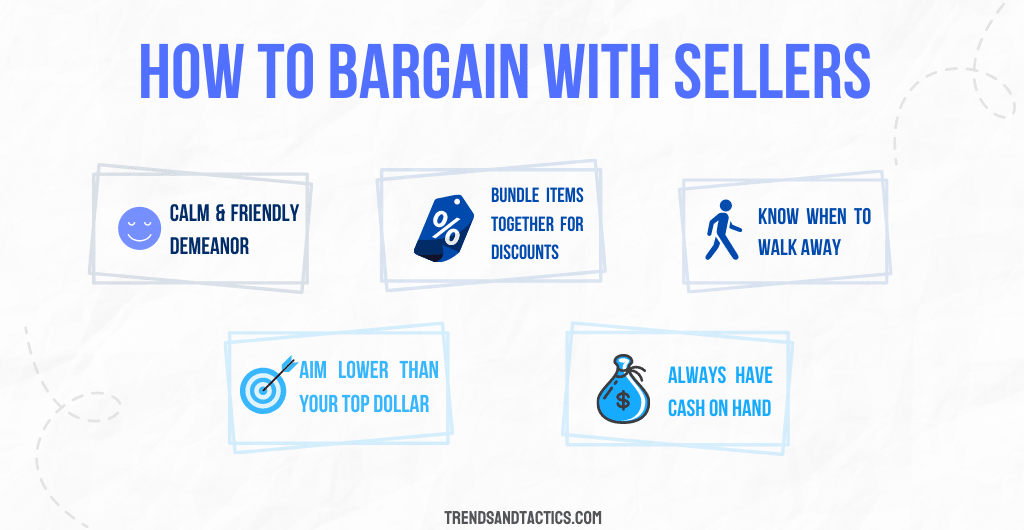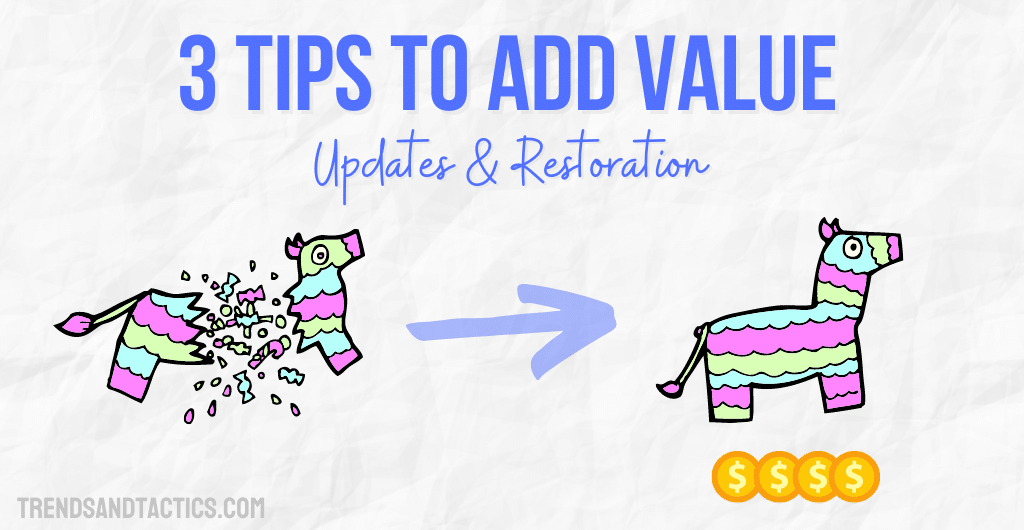In recent years, flea marketing has become so popular that there are television shows and YouTube series dedicated to documenting all the excitement and thrill.
Someone who hasn’t done this before may feel like they’re getting into the game late, or like they have too much to learn to figure out how to sell at a flea market.
That couldn’t be further from the truth! Even new sellers can make 200% to 300% more than they would at a simple garage or yard sale.
Here’s how to sell at a flea market, and walk away with more cash in your pocket, no matter your experience.
Why Do People Go to Flea Markets, Anyway?

When some people picture flea market sellers, they picture a bunch of older people gathering in a large parking lot to get rid of antiques they don’t want.
The face of flea marketing has changed a lot, though, and there are scenic views to take in if you go to the right markets. Here’s why people of all ages are taking part.
1. Gives Sellers The Chance To Be Creative
It’s rare to find a job that gives people the room to be as creative as possible while also making a significant profit.
For people who are tired of just typing away at computers or answer customer service calls, the chance to get hands-on and create something new out of something old can be alluring.
People like to figure out what to sell at a flea market to make money. It’s a challenge in creativity. For many creatives, it becomes a profitable second job.
Although not all sellers change the products from when they bought them, those who do enjoy this creative spark.
2. Allows Them To Connect With Others
Flea markets meet every week in a single location and draw many of the same people to come back time and time again. Because of this, a community grows within them.
Older sellers who have worked the lot for over twenty years, and new sellers who are just gaining their footing, can become friends and exchange ideas about how to sell at a flea market.
More than 60% of Americans have reported feeling lonely, and these markets give them a chance to socialize.
3. The Opportunity for Quick Sales
Although many items need to be updated, painted, or refinished, you can make easy money if you have a good eye for what to sell at a flea market to make money.
Items like collectibles, books, power tools, and older electronics can be turned around for quick money.
Some good-condition antiques can be turned around quickly such as silver spoons and flatware – but they only count if you’re able to get a reasonable price when you purchase them.
For some who have a full-time job during the week or aren’t able to set aside time for work because of child-raising or health issues, this job is simple enough to be worth it.
How to Find High Profit Items to Resell at Flea Markets

When starting, every seller needs some product to sell. Even if you inherited a large estate that you want to sell things from during the weekends, you’d eventually run out of products.
Here are the top things to consider when figuring out what to sell at a flea market to make money.
1. Consider Your Location
The location of where you’re selling should affect what you showcase in your booth.
If you find a large rack of vintage heavy coats for extremely cheap, you may feel inspired: but if you live in Florida, it’s not a smart buy.
What are the local tastes and wants? Although you shouldn’t cater to every item to the general public, you should try to ensure many of your things have broad appeal.
2. How Much Should You Spend?
Budget changes from person to person, but it’s essential to keep in mind that most markets take up to 20% off of what you’re pricing your items at.
Don’t spend more money than you’re willing to lose since this can be a gamble for most beginner flea market sellers.
When you see an item you like, figure out how much you’d like to sell it for, what you can do to increase the value, and how much of a profit you’d have leftover after that.
3. What’s Guaranteed To Sell?
Some items are popular enough that they’re nearly guaranteed to sell. The following are the top items that buyers will seek out.
You don’t have to purchase these items exclusively, but it’s a great idea to keep some of them in your shop.
These are the most common items purchased at flea markets:
- 93% stated they purchased jewelry, clothing, and toys, ranging from electronic games to diamond rings.
- 20% answered they purchased dining goods like flatware, china, and small appliances.
- Many stated they purchased artisan goods like soap and sweets that they can’t find otherwise.
- Others sought out antique furniture specifically, but these shoppers are pickier and will scan several booths before settling on one piece.
4. How To Bargain With Sellers

When you’re shopping around for items, it’s best not to do it at the same flea market that you’ll be selling at.
Although you may not think about it, some people who sell at flea markets can get annoyed or offended to find out that you’re flipping their products.
The most critical parts of bargaining for a good deal are:
- A calm but friendly demeanor plays a significant role. If you seem antsy or rude to them, the seller will be less likely to want to do business with you.
- Aim lower than your top dollar. If you want a dresser for $100 and have it for sale at $175, you should bid no higher than $80 and see what they say. Although this is a steep drop in price, you can come out ahead when you volley back and forth with them.
- If they don’t lower their price enough, you should stop trying. Don’t think that just because you’ve started a bargaining battle with a seller that you have to purchase from them. Your bottom line is essential, so don’t put it at risk by not knowing when to look away.
- Always have cash on you. Although many sellers offer Stripe, Venmo, and Paypal as options, it’s a good idea to have some money on hand just in case.
5. What Do You See The Most Often?
When you’re searching for things to resell, look for items you see more often than others.
This plan may sound counterintuitive, but if you can find a unique version of something that’s highly popular, it’s more likely to be able to sell.
Be careful if you see many antiques while searching for what to sell at a flea market to make money.
Researchers say up to 50% of antiques are fake, which could land you in a significant loss of money.
6. What Can You Flip For The Largest Profit?
Consider which items you can flip for the most considerable profit. Customers are more likely to want to spend more money on things that are both large and unique.
This means that your best bet is to win out on luck and find a large item for relatively cheap: or that you update an old item and give it some modern flair.
Don’t try to go too far out of your comfort zone to edit a thing if you’ve never done it before. For your first round, stick with only the work that’s familiar and practiced for you.
How to Add Value, a.k.a Updating and Restoring

A large part of ensuring what you have for sale sells at a reasonable price is updating and restoring old pieces.
This task could mean that you change everything about an item or stain the wood, so it looks like it did when it was first built. These are the things to consider when updating pieces.
Which Items Need To Be Updated?
Some items are more charming because they show their age. On top of this, refinishing old furniture poorly to try and match how it used to look can diminish or destroy any value it had.
Avoid removing patina from most copper items or ruining the cut or shape of any garments that have a vital cultural significance.
If the market is flooded with these items, it’s more okay to change or refinish them: but the rarer something is, the less changed it needs to be.
Older machines and tools can be cleaned, on the other hand, and often sell better when they’re updated to look new once more.
What Are The Most Common Fixes?
There are countless ways to update and fix furniture and belongings.
Here are some top methods people use and what they’re used for.
- UV strip whitening for older electronics. This works best for old game system cases or the shells of other electronics that have yellowed over time.
- Re-staining old wood that’s lost its luster.
- Cleaning and replacing the glass on clocks, mirrors, and other items.
- Cleaning old jewelry and removing signs of wear and tear.
- Removing stains from older goods.
- Repairing old fabrics through sewing.
Although you can still succeed without this extra work: this work ensures that your profit margin is more considerable, and you walk away with a more significant win.
Why Pushing It Further Is A High-Risk Game
Some will push it further and redesign or reimagine areas.
This can range from something as simple as updating an old bar cart to have glass shelves instead of metal, or it could go so far as cutting up a dresser and turning it into a gossip bench.
The problem with pushing it further like this is that you put in more time and effort and have to spend money on supplies and tools, and you have to question if it’s worth it.
Do the mental math on every item before purchasing it to ensure you’re not overspending on something that will flop.
How to Sell Successfully at Flea Markets, for Bigger Profits
The most exciting time has arrived! You have your items completed; you’re happy with how they look: and yet you’re not sure what to do about selling. Here’s what to consider when selling.
How To Find A Good Flea Market
Many newbies will choose whatever flea market is closest to them, but that can be a mistake.
The top ten flea markets in the country are far spread, and although they have booths of everything from artisan goods to original woodworking, 40% of their goods are still antiques.
When you’re trying to figure out where to sell, take a couple of Saturdays to shop around at the local flea markets.
Ask the following questions:
- How much does a booth cost?
- Is that cost per day or weekend?
- What hours is the market open?
- Are there any item restrictions?
- Do you have to supply your table? Many flea markets have them already set up.
- How many people come through the market every day it’s open?
- If you plan on selling often, it’s essential to ask if they have long-term booth renting options.
Try to find one that fits with what you want, along with having it be within a reasonable distance.
Although it’s worth it to drive an extra fifteen minutes for a flea market that’s larger and has more customers: going two or more hours is a commitment to try once you’ve succeeded already.
Tips For Laying Out Your Merchandise

How you place your merchandise will change how others perceive it and what they decide to pick up. Figure out the flow of traffic, and try to identify hot-sellers items a little closer to the booth and in a prominent position.
Vary the heights of your items to create a visually appealing layout that people will do more than glance at.
It would help if you also kept clutter at bay so that your customers only see things they can buy.
Some decorate their booths with lights and other pretty things. You can also do this, but keep in mind not all flea markets have power hookups, and that’s a cost that should wait.
How To Bargain With Buyers
After being a buyer yourself, you should know the general tricks buyers have when they approach your booth. All of your items should be listed for higher than what you would accept for them.
A 30% increase above gives you room to play with while possibly allowing you a significant win if a buyer doesn’t barter.
Play it close to the vest, be confident, and don’t let someone trick you into taking less than you deserve on an item.
Many sellers make money with eBay by selling items tougher to sell at flea markets.
When To Turn Down A Sale
The largest reason a flea market seller will lose out on income is that they accept a deal far lower than they should have.
If a piece has been sitting there for days, and you’re not sure if it’s ever going to sell: don’t try to underprice it.
It’s better to wait and sell it for a price you can accept rather than sell it off for cheap and lose the money that you’ve invested in it.
If a potential buyer is giving you the runaround and attempting to get your merchandise for far cheaper than you planned on selling it for: nip it in the bud.
Don’t cave out of desperation or get caught up in the moment. You deserve to be fairly paid for the work and time you put in.
How To Tell If You Should Do It Again
After you leave a thrift market and close out a day of selling, go over your numbers. What sold the most? What didn’t sell?
Some sellers can be surprised, finding out that 75% of their sales for a weekend were grab bags or that items they thought were a sure thing didn’t have any interest.
What Was Your Profit?
Look back at what you’ve sold, and consider if your profit was worth it. Flea markets offer great profit potential for adults, and even provide opportunities to make money as a teen.
You can calculate this by looking at how much you spent on the items, how much work went into updating or cleaning them, and how much money the customers paid you. The money leftover is your net profit.
How Much Time Did You Put In?
The time you put in isn’t just the amount of time you spent updating and refinishing things.
It’s also the time you spent loading your truck, getting out to the flea market, and standing in your stall. When you factor in all of this time, how much are you making per hour?
If it’s less than a living wage, or less than you’d want to accept, it might not be worth it.
Did You Enjoy It?
Even if your profits aren’t significant, if you had a great time or love flea marketing, it may be worth it to you.
People love the sense of community, the chance to make a big sale, and the ability to be as creative as they want. As long as you’re not losing money, if you’re having a great time, it could be worth it.
If it turns out flea markets aren’t for you, you can try something different like selling clothes online or setting up sales more directly with Facebook Marketplace.
Conclusion
Flea markets’ goal is to give sellers the chance to make some money off their wares and allow buyers to buy something they might not have found anywhere else.
As long as you’re buying things for far cheaper than you’re selling them and keeping a cool head in bargaining, you can come out with a significant profit.
Erin is a business teacher and mother of three. When she’s not in the classroom or fulfilling her obligations as an A+ hockey and lacrosse mom, she’s working on her latest article.






